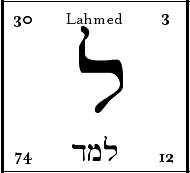A • B • C • D • E •
F • G • H • I • J • K • L •
M
N • O • P • Q • R •
S • T • U • V • W • X • Y •
Z
Hebrew:
Aleph • Beit • Geemel • Dalet •
Hay • Vahv • Zaiyin • Chait • Tait
Yoad • Kaf • Lahmed • Mame • Nune •
Sahmek • Aiyin • Pay
Tzahday • Qoaf •
Raysh • S(h)een • Tahv

Lahmed
Spelling: lahmed mame dalet
Lahmed is understood as a vahv looking down upon a kaf upon which
it is standing. It can also be understood as the heart ascending
toward a yoad — or God. The spelling of lahmed is an acronym for
the Hebrew phrase meaning ‘a heart
that
understands
wisdom
or teaching’
(lev
meivin da’at). The implication here is the divine or prophetic
intelligence ‘breaking through’ the barrier between earthly and
supernal understanding through attention, desire and practice.
Adam
and Eve represent primeval archetypes of emanation and reception.
Adam is commonly
understood
as the
embodiment of mind, and Eve as the embodiment of the heart or
emotion. Together, they form a symmetry where each rises up to
learn from
the other, back and forth — a unity which is continually growing.
In Hebrew literature, however, Adam is generally understood as
the teacher and Eve as the student.
Only lahmed ascends
above
the top of all other letters, indicating at once ‘a teaching
bestowed from above’ and ‘the student’s ascent through learning’.
This combination
must lead to enaction in order to be fulfilled, and thus lahmed
is also seen as a prod or goad, something which enables the direction
of baser energies and inspirations toward supernal goals and
embodiments.
Lahmed as ‘The Serpent’:
Though the letter tait is associated with the snake, and though
this is rarely or never mentioned in Judaic teachings, it is clear
that of all the letters, lahmed most resembles a snake. This would
not be in keeping with the common understandings of ‘rising above’
the other letters, and here we find probable cause for this omission.
Although it is not entirely clear whether the snake was actively
associated with the Tree of Knowledge in the Garden of Eden, it
was the source of the temptation of Eve to eat of the fruit of
the Tree. Eve}s vulnerability is not entirely surprising, as the
snake is the only
creature
whose
form
resembles
a phallus,
the generative organ of her companion.
The snake’s subtlety is
at once an indication of mischievousness and sophistication, and
in fact
the first debate in the bible occurs in Genesis III
between Eve and the serpent, as it encourages her to ‘become
like God’ through the act of eating of the Tree.
Knowledge is actually an activity
requiring
separating and dividing that which is in reality perfectly
unified, and this ‘falsified division’ is most likely what was
received
at the Tree. Perhaps the most serious and deadly aspect of
this reception is that it
may
have occluded the natural and innate experience of divine unity
present
in all things and beings. We can see in this story another
similarity to lahmed: the serpent ‘prods or goads’ Eve into taking
of the fruit of the
Tree.
o:O:o
o:O:o
Family: Existential: Actualized in existence within
the spiral/cone of transentient emanation. Existing within space-time.
The second 9 letters.
Archetypal: Geemel
Existential: Lahmed
Supernal: S(h)een
Position: The twelfth letter. The seventh ‘twelve elementals’ or
simples.
Common associations:
Primary Significations: A goad or prod. To teach or point out.
Secondary Significations: To prompt to action. The receptivity
of the heart in its desires to learn. The emanative quality of
the desire to teach. Empirical knowledge.
Body: The gall bladder.
Power: Intercourse.
Sign: Libra.
Archetype / Tribe: Ephraim
Element:
Path on the Tree of Life:
Traditional: Hod / Yesod
Hermetic: Geburah / Tiphareth
Lahmed
A • B • C • D • E • F • G • H • I • J • K • L • M
N • O • P • Q • R • S • T • U • V • W • X • Y • Z
Hebrew:
Aleph • Beit • Geemel • Dalet • Hay • Vahv • Zaiyin • Chait • Tait
Yoad • Kaf • Lahmed • Mame • Nune • Sahmek • Aiyin • Pay
Tzahday • Qoaf • Raysh • S(h)een • Tahv